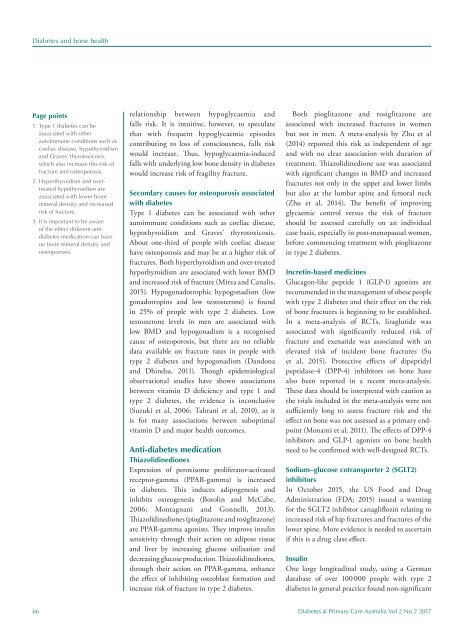DPCA2-2_issue_v3
Create successful ePaper yourself
Turn your PDF publications into a flip-book with our unique Google optimized e-Paper software.
Diabetes and bone health<br />
Page points<br />
1. Type 1 diabetes can be<br />
associated with other<br />
autoimmune conditions such as<br />
coeliac disease, hypothyroidism<br />
and Graves’ thyrotoxicosis,<br />
which also increase this risk of<br />
fracture and osteoporosis.<br />
2. Hyperthyroidism and overtreated<br />
hypothyroidism are<br />
associated with lower bone<br />
mineral density and increased<br />
risk of fracture.<br />
3. It is important to be aware<br />
of the effect different antidiabetes<br />
medication can have<br />
on bone mineral density and<br />
osteoporosis.<br />
relationship between hypoglycaemia and<br />
falls risk. It is intuitive, however, to speculate<br />
that with frequent hypoglycaemic episodes<br />
contributing to loss of consciousness, falls risk<br />
would increase. Thus, hypoglycaemia-induced<br />
falls with underlying low bone density in diabetes<br />
would increase risk of fragility fracture.<br />
Secondary causes for osteoporosis associated<br />
with diabetes<br />
Type 1 diabetes can be associated with other<br />
autoimmune conditions such as coeliac disease,<br />
hypothyroidism and Graves’ thyrotoxicosis.<br />
About one-third of people with coeliac disease<br />
have osteoporosis and may be at a higher risk of<br />
fractures. Both hyperthyroidism and over-treated<br />
hypothyroidism are associated with lower BMD<br />
and increased risk of fracture (Mirza and Canalis,<br />
2015). Hypogonadotrophic hypogonadism (low<br />
gonadotropins and low testosterone) is found<br />
in 25% of people with type 2 diabetes. Low<br />
testosterone levels in men are associated with<br />
low BMD and hypogonadism is a recognised<br />
cause of osteoporosis, but there are no reliable<br />
data available on fracture rates in people with<br />
type 2 diabetes and hypogonadism (Dandona<br />
and Dhindsa, 2011). Though epidemiological<br />
observational studies have shown associations<br />
between vitamin D deficiency and type 1 and<br />
type 2 diabetes, the evidence is inconclusive<br />
(Suzuki et al, 2006; Tahrani et al, 2010), as it<br />
is for many associations between suboptimal<br />
vitamin D and major health outcomes.<br />
Anti-diabetes medication<br />
Thiazolidinediones<br />
Expression of peroxisome proliferator-activated<br />
receptor-gamma (PPAR-gamma) is increased<br />
in diabetes. This induces adipogenesis and<br />
inhibits osteogenesis (Botolin and McCabe,<br />
2006; Montagnani and Gonnelli, 2013).<br />
Thiazolidinediones (pioglitazone and rosiglitazone)<br />
are PPAR-gamma agonists. They improve insulin<br />
sensitivity through their action on adipose t<strong>issue</strong><br />
and liver by increasing glucose utilisation and<br />
decreasing glucose production. Thiazolidinediones,<br />
through their action on PPAR-gamma, enhance<br />
the effect of inhibiting osteoblast formation and<br />
increase risk of fracture in type 2 diabetes.<br />
Both pioglitazone and rosiglitazone are<br />
associated with increased fractures in women<br />
but not in men. A meta-analysis by Zhu et al<br />
(2014) reported this risk as independent of age<br />
and with no clear association with duration of<br />
treatment. Thiazolidinedione use was associated<br />
with significant changes in BMD and increased<br />
fractures not only in the upper and lower limbs<br />
but also at the lumbar spine and femoral neck<br />
(Zhu et al, 2014). The benefit of improving<br />
glycaemic control versus the risk of fracture<br />
should be assessed carefully on an individual<br />
case basis, especially in post-menopausal women,<br />
before commencing treatment with pioglitazone<br />
in type 2 diabetes.<br />
Incretin-based medicines<br />
Glucagon-like peptide 1 (GLP-1) agonists are<br />
recommended in the management of obese people<br />
with type 2 diabetes and their effect on the risk<br />
of bone fractures is beginning to be established.<br />
In a meta-analysis of RCTs, liraglutide was<br />
associated with significantly reduced risk of<br />
fracture and exenatide was associated with an<br />
elevated risk of incident bone fractures (Su<br />
et al, 2015). Protective effects of dipeptidyl<br />
peptidase-4 (DPP-4) inhibitors on bone have<br />
also been reported in a recent meta-analysis.<br />
These data should be interpreted with caution as<br />
the trials included in the meta-analysis were not<br />
sufficiently long to assess fracture risk and the<br />
effect on bone was not assessed as a primary endpoint<br />
(Monami et al, 2011). The effects of DPP-4<br />
inhibitors and GLP-1 agonists on bone health<br />
need to be confirmed with well-designed RCTs.<br />
Sodium–glucose cotransporter 2 (SGLT2)<br />
inhibitors<br />
In October 2015, the US Food and Drug<br />
Administration (FDA; 2015) <strong>issue</strong>d a warning<br />
for the SGLT2 inhibitor canagliflozin relating to<br />
increased risk of hip fractures and fractures of the<br />
lower spine. More evidence is needed to ascertain<br />
if this is a drug class effect.<br />
Insulin<br />
One large longitudinal study, using a German<br />
database of over 100 000 people with type 2<br />
diabetes in general practice found non-significant<br />
66 Diabetes & Primary Care Australia Vol 2 No 2 2017
















